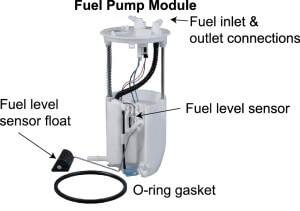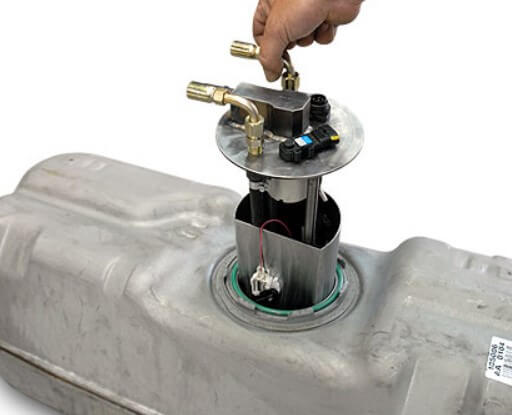Why fuel pump replacement costs so much
Fuel pump replacement can easily cost $800 or more. Here’s why it’s so expensive
When your fuel pump goes bad, owners are usually stunned by the high fuel pump replacement cost and wonder if they’re getting scammed. If you own a late model fuel injected vehicle, the fuel pump module is usually replaced as a complete unit, rather than replacing just the fuel pump. The

The fuel pump module housing contains the fuel pump, pulsator, filter sock, fuel level sensor, float and float arm, inlet and outlet connections, and springs to keep the unit at the bottom of the tank
module is located INSIDE the gas tank and to replace the fuel pump module, you have to drain and remove the entire gas tank. Before we dive into fuel pump replacement costs, let’s take a look and why they go bad and what goes into the replacement.
Dissecting fuel pump replacement cost
Let’s look at why fuel pump replacement cost is so high. We’ll use a 2010 Buick Enclave as an example. This vehicle actually has two fuel pumps; one in the tank that brings fuel pressure to around 50-psi, and a second fuel pump on the engine that boosts fuel pressure to almost the 2,000-psi needed to operate the gasoline direct injection system.
The flat rate guide shows that it takes 2.9-hrs. to drain and refill the tank and remove and replace the fuel pump module. The 2.9 hours does not include cleaning the tank. The pump itself lists for $410.00. With a shop rate of around $140-hr, the labor comes to about $406 and the fuel pump $410, bring the job to at least $$816
Here’s a step by step guide to fuel pump replacement for a Buick Enclave
Draining the fuel tank takes about 20-mins, depending on how full it is
Disconnecting the fuel line and evaporative emissions system from the tank takes about 10-mins.
Removing the tank from the vehicle takes about 10-mins once it’s drained
Unlocking the fuel pump locking ring and removing the old pump takes about 10-mins.
Cleaning the gas tank can take up to one hour depending on how much crud is inside.
Installing the new fuel pump module and reinstalling the tank takes about 30-mins.
What causes fuel pumps to go bad?
If you really want to kill your fuel pump fast, just run your car out of gas. Running out of gas is one of the major causes of fuel pump failure. Car makers rely on the gasoline in your tank to cool the electric motor that spins the fuel pump’s impeller. When you run out of gas, the motor overheats. In addition, it starts sucking in the last bit of gas in your tank and that gas can contain dirt and grit that’s settled at the bottom of the tank over the years. Yes, there’s a filter on the fuel pump to keep the crud out, but the pump’s suction is strong enough to pull that crud in if you let it run too low. If you routinely run your car with less than ¼ tank, you run the risk of early fuel pump failure.
However, there are other reasons why fuel pumps fail. The fuel pump module contains the fuel pump, a check valve, a pulsation damper, fuel post-pump fuel filter and the fuel level sensor. The check valve is designed to keep pressure in the fuel line when you shut off the engine. That way, pressurized fuel is ready to go as soon as you turn the key. It’s common for fuel line pressure to fall about 5-psi when the shut the engine down. But if the check valve goes bad, all the fuel will drain back into the tank and you’ll experience long crank times when you try to start the engine after its been sitting. Unfortunately, car makers don’t offer the check valve as a separate item. Even if they did, your mechanic would still have to drain and remove the gas tank and remove the entire fuel pump module to replace the check valve.
A faulty pulsation damper can cause the fuel pump to make noise and a clogged post-fuel pump filter can put extra strain on the fuel pump and cause it to fail early. Finally, a bad fuel pump relay, fuel pump flow control module or bad fuel pump ground cause a voltage drop that can overheat the motor windings and cause fuel pump failure.
©, 2016 Rick Muscoplat
Posted on by Rick Muscoplat

